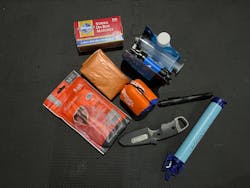Your Emergency Survival Bag: What Items Are Essential?
For decades I’ve espoused the idea of having an emergency bag either with you or within easy access “just in case.” For a long time I used the Camelbak Transformer hydration pack as my basic platform simply because it was adaptable. It could be just a hydration pack or you could add one or two pockets to carry gear. It was just big enough, with the pockets, to carry everything I thought I’d need to survive a couple nights out in the wilds if I was caught in such unaware. In the past couple years I’ve switched over to the 5.11 Tactical AMP 12 pack as my basic platform simply because of its modular capability. You can select an outer pouch/pocket that suits your needs or your particular way of organizing items. What should those items be?
As with all emergency packs, yours should provide you with the means of creating shelter, generating and maintaining warmth, collecting and purifying water and, space allowing, some emergency rations of some sort. For shelter I’ve used everything from a surplus military poncho to a cheap 5’ by 7’ tarp from the local hardware store. As long as it’s waterproof and has some secure grommets you can hook cord through, it can be used. And speaking of cord, a length of paracord (550 cord) is essential to have.
To create warmth and retain it, you’ll need to have means of starting a fire and something to wrap around yourself to retain body heat. Emergency fire starter kits are available online or you can make your own with any small waterproof container, some white-tip strike-anywhere matches and a few cotton balls with Vaseline rubbed on them. Emergency “space” blankets can be had for as little as a dollar each and the mylar ones (the quality ones) reflect back as much as 90% of your body heat.
A Lifestraw or other water filtration system is a good idea and some type of bladder or other container you can hold purified water in. Micro-filters aren’t expensive… just search Amazon. Food rations are up to you. Some people use granola bars or other snack bars; others use their own homemade trail mix concoction. As log as what you have provides you a mix of protein, fat, carbs and sugar, you’re good to go.
Of course, no emergency kit is complete without a flashlight (I recommend an LED lamp driven by AA batteries), a knife (a short fixed blade or locking folder), a signaling device (such as a small mirror) and a whistle. Those last two items assume you require rescue, but they take up so little space, why not have them? A final recommended piece for the kit is a small first-aid or trauma pack. A tourniquet, pressure bandage and a hemostatic agent can solve a lot of life-threatening problems, or at least make them temporarily manageable.
I packed my emergency bag for 24 to 48 hours, but could have stretched that to 72 hours if I rationed my food out, or hunted/snared food. What’s in yours?
About the Author
Lt. Frank Borelli (ret), Editorial Director
Editorial Director
Lt. Frank Borelli is the Editorial Director for the Officer Media Group. Frank brings 20+ years of writing and editing experience in addition to 40 years of law enforcement operations, administration and training experience to the team.
Frank has had numerous books published which are available on Amazon.com, BarnesAndNoble.com, and other major retail outlets.
If you have any comments or questions, you can contact him via email at [email protected].

